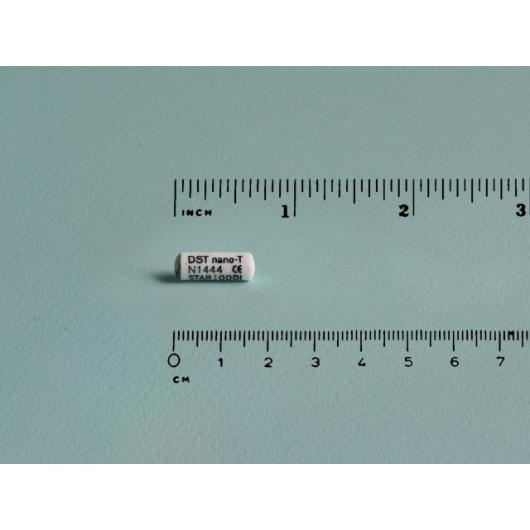
Logger for temperature measurements, the smallest
Key features
- Ideal for biomedical or animal welfare studies
- Constant and accurate temperature measurements
- Simple to use and cost effective
- Multiple animals in a cage (biomedical studies)
- Size only 17 mm x 6 mm, weighing only 1,3 g
Description
The DST nano-T is the world's smallest temperature data logger. Recorded data is stored in the logger‘s internal memory with a real time clock reference for each measurement.
The DST nano-T is supported by the Mercury (and SeaStar) software and the Communication Box which serves as an interface between the logger and a PC. When logger is placed in the Communication Box the wireless communication between logger and box can be established.
In the software, the user sets the start time, start date and sampling interval before starting the recorder. Up to seven different intervals can be set for the same measurement sequence. This is especially useful when more frequent measurements are needed at a certain time period.
After recovering the DST, recorded data is uploaded in the supporting software where results are displayed both in graphic and tabular form. After retrieving the data, the DST can be re-programmed and reused as long as the battery lasts.
A set of Communication Box and SeaStar software needs to be purchased with the first order.
Examples of application
DST nano-T was designed to be used as an implantable thermo logger for wild and captive animals. DST nano-T is made of biocompatible materials (alumina and biocompatible epoxy) and its size and shape are ideal for implantation in small animals. The logger can also be fitted in tight spaces, small packages or vials, for e.g. heat studies or temperature monitoring. With its waterproof housing and carefully chosen materials the DST nano-T can be used for collecting temperature data underwater or in other liquids (tolerates chemicals well).
The DST nano-T temperature logger is suitable for studies within:
- Laboratory animal science
- Preclinical research, stability and toxicology studies
- Quality control (e.g. packaging)
- Tagging of small fish and animals
- Any use where ultra small and lightweight temperature recorder is required
- Sensor: temperature
- Size (diameter x length): 6 mm x 17 mm
- Housing material: alumina and biocompatible epoxy
- Weight: 1.3 g
- Data resolution: 12 bits
- Temperature range: 5 to 45°c (41°f to 113°f)**
- Temperature resolution: 0.032°c (0.058°f)
- Temperature accuracy: +/-0.2°c (+/-0.36°f)
- Temperature response time: time constant (63%) reached in 5 sec.
- Pressure tolerance: customer defined: up to 100 bar/1000 m
- Memory type: non-volatile eeprom
- Memory capacity: 43,477 measurements
- Memory mangement: custom programming
- Sampling interval: user specified in second(s), minute(s) or hour(s)
- Minimum measuring interval: 1 second
- Multiple intervals option: up to 7 different intervals
- Data retention: 10 years
- Clock: real time clock. Accuracy +/-1 min/month
- Communications: communication box, wirelss transmission when dst sits in the box. Connection to pc: usb cable
- Battery life: 14 months*
- Replaceable battery: no
*with a sampling interval of 10 min at room temp.
**outside ranges available upon request.
- COMBOX Communication box with USB converter
- MERCURY Mercury software for DST system
2015
Zheng Z, Ferretti V, Güntan I, Moro A, Steinberg EA, Ye Z, Zecharia AY, Yu X, Vyssotski AL, Brickley SG, Yustos R, Pillidge ZE, Harding EC, Wisden W, Franks NP.
Neuronal ensembles sufficient for recovery sleep and the sedative actions of α2 adreneric agonists.
Nature Neuroscience (2015) Feb doi:10.1038/nn.3957.
2013
Houspie L, Stevens H, Ngotho M, Keyaerts E, Ispas G, Verloes R, Maes P. (2013).
In Vivo Evaluation of Antiviral Compounds on Respiratory Syncytial Virus Using a Juvenile Vervet Monkey (Chlorocebus pygerythurus) Infection Model.
In E.Y. Gong (Ed.), Antiviral Methods and Protocols.(Methods in Molecular Biology, vol. 1030, 373-382). Springer Protocols.

